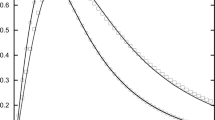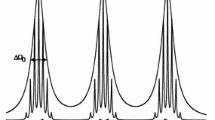Summary
A new interpretation of the electron spin resonance spectrum [2, 5] of X-irradiated pure cholesterol powder was established because inGordy's former interpretation [5] the difference between the hyperfine splittings of the ESR spectrum from axially and equatorially oriented H atoms in the cyclic part of the cholesterol molecule was neglected. The new interpretation (Cholesteryl-7) was found with regard of data fromOnishi andNitta measured on the cyclohexenyl radical [10], by identifying the triplet splitting (a=26 Oe) in the ESR spectrum of irradiated cholesterol with both axial Hβ1 resp. H′β1 atoms and correlating the doublet splitting (a=15 Oe) with the Hα2 atom and by accepting the hyperfine splittings of the Hα1 atom and of the equatorial Hβ2 atom not exceeding 6 Oe and therefore not being resolved because of the considerable line width of about 10 Oe. The unpaired electron's localisation near the double bond was shown by a control experiment with 5,6-dihydrocholesterol.
Zusammenfassung
Das Elektron-Spin-Resonanz-Spektrum von röntgenbestrahltem, reinem Cholesterinpulver [2, 5] wurde neu interpretiert, da in der vonGordy früher vorgeschlagenen Deutung [5] der Unterschied in der Hyperfeinaufspaltung des ESR-Spektrums durch axial und äquatorial orientierte H-Atome im cyclischen Teil des Cholesterinmoleküls vernachlässigt wurde. Die neue Interpretation, die zu der Radikalstruktur Cholesteryl-7 führte, ergab sich, wenn man unter Berücksichtigung der vonOnishi undNitta am Cyclohexenylradikal gemessenen Daten [10] die Triplettaufspaltung (a=26 Oe) im ESR-Spektrum des bestrahlten Cholesterins den beiden axialen Hβ1- bzw. H′β1-Atomen und die Dublettaufspaltung (a=15 Oe) dem Hα2-Atom zuordnete und annahm, daß die Hyperfeinaufspaltungen des Hα1-Atoms und des äquatorialen Hβ2-Atoms wegen der beträchtlichen Linienbreite von ca. 10 Oe nicht aufgelöst waren, also höchstens ca. 6 Oe betrugen. Die Lokalisierung des ungepaarten Elektrons in der Nähe der Doppelbindung wurde durch ein Kontrollexperiment mit 5,6-Dihydrocholesterin nachgewiesen.
Similar content being viewed by others
Literatur
Deffner, U.: Dissertation, Technische Hochschule München 1965.
Ehrenberg, A., L.Ehrenberg, u. G.Lofroth: Riso Report16, (1960), zitiert in:Bielski, B. H. J., and J. M.Gebicki: Atlas of ESR Spectra. New York and London: Academic Press 1961.
Fessenden, R. W., andR. H. Schuler: J. Chem. Phys.39, 2147 (1963).
Fieser, L. F.: Lehrbuch der organ. Chemie, p. 1141. Weinheim: Verlag Chemie 1960.
Gordy, W.: Rad. Res. Suppl.1, 491 (1959).
Ingram, D. J. E.: Free radicals as studied by electron spin resonance. London: Butterworth 1958.
Karlson, P.: Biochemie. Stuttgart: Thieme 1964.
Lück, H., U. Deffner undR. Kohn: Fette, Seifen66, 665 (1964).
Müller, A.: Progr. Biophys. molec. Biol.17, 99 (1967).
Onishi, S. I., andI. Nitta: J. Chem. Phys.39, 2848 (1963).
Rexroad, H. N., andW. Gordy: Bull. Amer. Chem. Soc. II1, 200 (1956).
Zimmer, K. G., W. Köhnlein, G. Hotz undA. Müller: Strahlentherapie120, 165 (1963).
Author information
Authors and Affiliations
Additional information
Ich danke Herrn Prof. Dr. O.Hug für die Anregung, das Cholesterin hinsichtlich der Wirkungen ionisierender Strahlung zu untersuchen. Den Herren Dr.U. Deffner andG. Brausse bin ich für die Mithilfe bei den ESR-Untersuchungen zu Dank verpflichtet. Die Arbeit ist ein Teil aus einer an der Technischen Hochschule München vorgelegten Dissertation.
Rights and permissions
About this article
Cite this article
Hellinger, O. Elektron-Spin-Resonanz freier Radikale in röntgenbestrahltem Cholesterin und 5,6-Dihydrocholesterin. Biophysik 6, 63–68 (1969). https://doi.org/10.1007/BF01403869
Received:
Issue Date:
DOI: https://doi.org/10.1007/BF01403869




